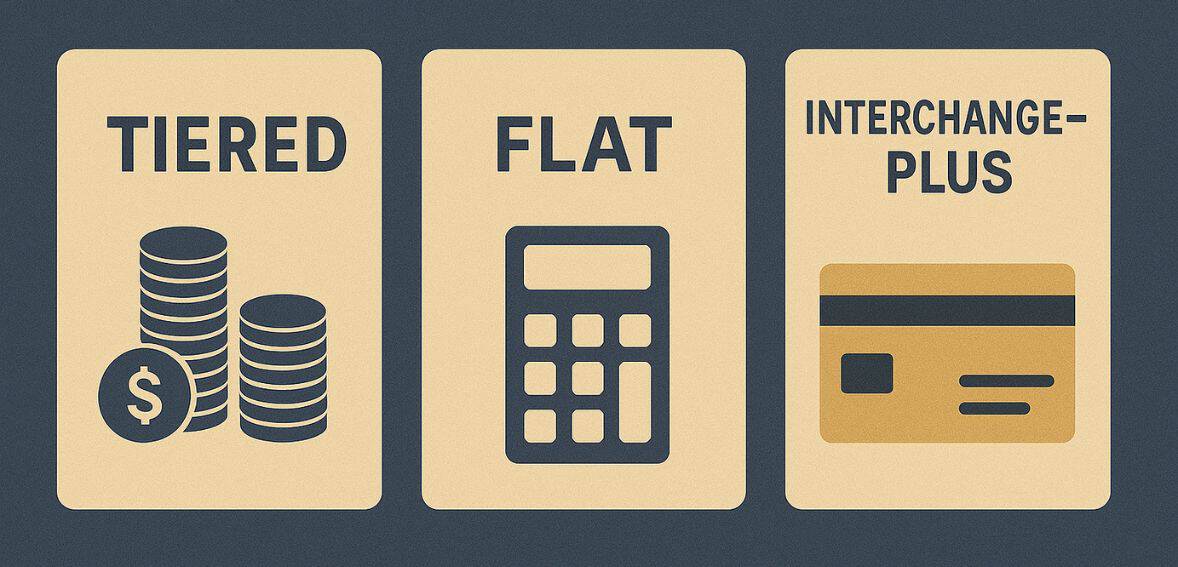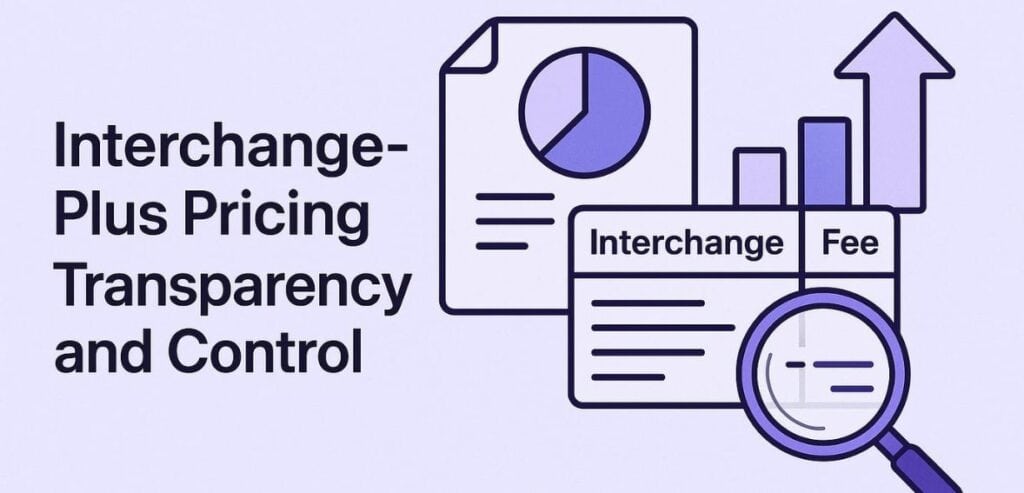
By alphacardprocess July 9, 2025
All merchants are aware that there are fees associated with accepting card . Still few stop to think about how the pricing model—the structure of those fees—can drastically change operational clarity and profitability. The model you select determines your cost, transparency, and scalability, regardless of whether you’re a busy online retailer, a high-volume practice provider, or a specialty shop.
There are advantages and disadvantages to tiered, flat, and interchange-plus pricing. By incorporating expert viewpoints and real-world insights, this investigation demystifies these models and assists companies of all sizes in making well-informed, strategic decisions.
Flat‑Rate Pricing: Simplicity at a Premium

Regardless of the channel, card type, or purchase amount, flat-rate pricing offers a single, consistent fee for each transaction. With their straightforward, understandable pricing—possibly 2.9% plus 30 cents per transaction—brands like Square, PayPal, and Stripe have made this model widely known. That predictability? It’s a lifesaver for small businesses just getting started. But here’s the catch—you’re almost always overpaying in the long run.
The entire interchange cost, which varies depending on the type of card and risk profile, is borne by the processor. In the hopes that it will cover every situation, they incorporate their margin into that flat rate. This implies that the processor may absorb losses on premium reward cards while the merchant may be overcharged on low-value transactions or debit cards with low interchange. According to the industry publication Practical Ecommerce, flat-rate merchants benefit from predictable pricing—knowing exactly what each transaction will cost—but they often lack visibility into potential overpayments or profit margins.
Tiered Pricing: Familiar but Opaque
Transactions are categorized into three main groups using tiered or bundled pricing: qualified, mid-qualified, and non-qualified. The lowest rates are obtained for qualified transactions, like in-person chip card swipes. Keyed-in or rewards card transactions may fall under the mid-qualified category, while corporate or international cards, which have the highest rates, are typically covered by the non-qualified category.
Tiered pricing is often promoted with rates ‘as low as X%,’ which can be appealing at first glance, but the underlying structure may involve complexities that are not immediately evident and can affect overall costs. The processor maintains complete control over classification, and merchants rarely know ahead of time which tier a transaction will fall into.
This often leads to unpredictable cost fluctuations and makes it difficult to compare competitor pricing, as noted by industry experts. The prevalence of tiered models among legacy providers says it all: transparency declines while simplicity reigns.
Interchange‑Plus Pricing: Transparency and Control

Cost-plus pricing, also known as interchange-plus pricing, provides insight into actual expenses. The processor adds a fixed markup, which can be either a percentage or cents per transaction, after passing through the precise interchange fee that has been set by card networks (Visa, Mastercard, etc.). Businesses can see exactly what goes to the card issuer and what the processor keeps thanks to this configuration, which provides clarity.
Larger retailers benefit from this model because it allows them to negotiate markups. When compared to flat or tiered models, register-based and online businesses with mixed or high-value transactions frequently save a significant amount of money. The advantage? Accountability and cost effectiveness. The drawback is that interchange rates change every two years, and monthly statements include hundreds of fee line items.
Processor Contracts, Hidden Fees, and the Real Cost of Simplicity
The fine print of processor agreements can have a significant impact on the actual cost of a business’s pricing model decision even after it has been made. Though platform fees, monthly minimums, or fees for PCI compliance and chargebacks are less obvious, flat-rate providers are frequently commended for their plug-and-play experience.
For instance, a provider may offer a flat rate of 2.9% but still impose pass-through fees or a monthly subscription fee on specific card types. When these costs aren’t mentioned during onboarding, the upfront simplicity may not translate into overall cost-effectiveness.
There is an even higher chance of hidden costs with tiered pricing. Transactions are frequently categorized into “qualified” or “non-qualified” buckets based on the provider’s whims, and merchants usually have no control over the regulations governing this process. Depending on how it was entered or which provider terminal was used, the same card transaction may be processed differently each month.
Even though interchange-plus offers a more transparent fee breakdown, some processors may dilute the initial cost benefits by adding layered surcharges, markup buffer zones, or even deceptive account maintenance fees. The secret to getting what you signed up for is to read and comprehend the merchant statement each month.
Understanding the full scope of your processor’s pricing and contract structure is just as important as choosing the pricing model itself. Emphasizing the value of transparent pricing, businesses can avoid unexpected fees and make more informed decisions.
Future-Proofing with Scalable Pricing Models and Data Visibility

The payment method that was effective yesterday might not be suitable for today’s demands as businesses grow. When monthly transactions reach tens or hundreds of thousands, a flat-rate model that helped a startup grow initially may become a barrier. Once cherished simplicity could begin to feel like a limit on possible productivity. By providing a clear line of sight into fees, transaction types, and negotiation room as scale increases, Interchange-plus, on the other hand, expands with the company.
More significantly, modern payment methods ought to be integrated with the larger financial framework of an organization. Payment gateways and processors with sophisticated reporting features are essential for companies looking to make well-informed marketing or operational decisions. Dashboards that break down fees by region, card type, or even promotional seasonality are frequently included with interchange-plus processors pricing.
Financial teams can measure the performance of payment channels, identify lucrative customer segments, and even forecast future expenses thanks to this degree of visibility. CFOs and business owners who intend to look into financing options, M&A prospects, or international expansion must have access to this type of detailed, data-rich reporting.
In general, flat-rate and tiered pricing models offer less information, which makes it more challenging to prepare for audits and financial forecasting. Transparency in pricing in the digital age helps people make better decisions rather than just saving a few pennies on a transaction. Long-term-focused businesses should select a pricing strategy that will not only help them now but also enable their next big move.
Comparing the Models
The predictability and simplicity of flat-rate become significant advantages for many small or early-stage businesses, particularly when speedy onboarding takes precedence over margin optimization. Operational simplicity may have a greater impact than hidden interchange costs when order values are low and sales volumes are modest.
Advertised low rates can be used to entice customers with tiered pricing, but retailers need to consider how frequently “qualified” rates are applicable. Costs may suddenly increase for a company that uses reward cards or e-commerce heavily. Operations and financial planning are at long-term risk due to the provider’s lack of transparency.
Interchange-plus becomes the dominant option when a company expects increased volume, a variety of payment methods, or margin sensitivity. It enables informed choices, such as separating card network expenses from provider profit, negotiating processor markup through internal data analysis, and identifying areas for savings.
As they expand, wise companies frequently switch from flat or tiered models to interchange-plus. When comparing pricing models, it’s important to factor in typical credit card processing fees to get a complete picture of your expenses.
Real‑World Experiences and Lessons
Stories reinforce these lessons in everything from professional analysis to Reddit discussions. With a volume of $2–3 million and average tickets of about $100, a Canadian restaurateur compared flat-rate and interchange-plus and found that interchange-plus offered significant cost savings, promising a markup of 0.13% plus cents per transaction as opposed to a 2% flat rate.
Interchange-plus was consistently less expensive for others with higher e-commerce volumes, particularly after accounting for card mix and negotiation. On the other hand, because they valued simplicity in billing, merchants with low volume or subscription models occasionally kept flat-rate agreements. Even so, complications can arise because of things like PCI fees, hidden monthly minimums, or cross-border charges, which can distort the actual cost and highlight the importance of carefully reading offers and asking questions.
Choosing the Right Model: Strategic Questions
Choosing a pricing model is a strategic choice as much as a technical one. Start by looking at the card mix, average ticket size, and transaction volume. Find out if your company depends on high-risk industries, e-commerce, foreign clients, or in-person sales. Recognize whether you’re investing in transparency and control later or simplicity now. Regularly review pricing as volume increases.
When moving to interchange-plus, bargain for processor markups. Use tiered models to monitor processor attempts to downgrade your transactions. Request complete disclosures from flat-rate providers, including information on chargebacks, loyalty programs, and cross-border cards.
Implementing and Monitoring Your Choice

After selecting a model, integration and supervision are important. Verify that all non-interchange fees are included in your monthly fees for flat-rate providers, and use reconciliation automation to identify any irregularities. Track the proportion of transactions that fall into each tier and request monthly classification reports for tiered pricing. Tiered pricing may still be successful if qualified transactions predominate.
Active participation is necessary for Interchange-plus: go over your statements line by line, look for interchange spikes, and compare markup to rivals. To calculate the effective rate, divide the total fees by the total volume using transaction data. Engage in frequent negotiations. Even modest cuts of 0.1% can result in yearly savings of thousands.
When to Make the Switch
Scaling into interchange-plus is where many businesses find the sweet spot. As transaction volume increases or payment types diversify, transparency becomes a critical asset for cost management and decision-making, as highlighted by Practical Ecommerce. Start talking now rather than waiting for a long-term contract to expire. Once they grasp interchange, even small-scale retailers demonstrate early cost savings over flat-rate façades.
Conclusion
Different philosophies are reflected in interchange-plus, flat, and tiered pricing. Easy bets with a flat rate. Tiered conceals intricacy behind buckets. Interchange-plus provides negotiation power and transparency. Your company’s size, complexity, and opacity versus optimization tolerance will determine which model is best for you.
Simplicity appeals to smallness, but clarity is necessary for maturity and ambition. In the end, your pricing strategy should be in line with your values. Which do you value more: economical precision, cost certainty, or ease of use? Knowing each model enables you to make that decision with assurance, wisdom, and a clear picture of the direction your company is taking.